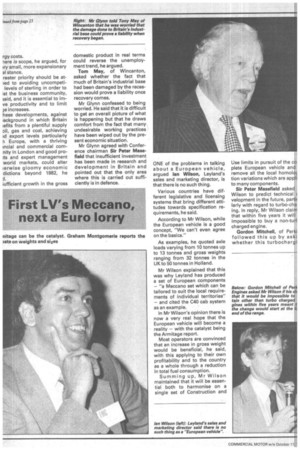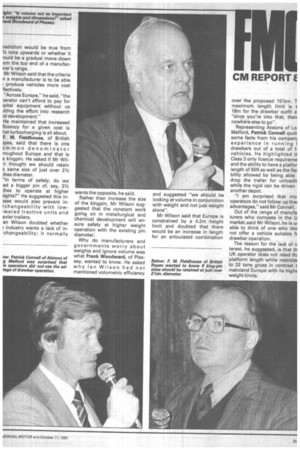Ilan Millar listens to a message of hope from CBI
Page 17

Page 18

Page 19

If you've noticed an error in this article please click here to report it so we can fix it.
economics chief kirmot Glynn. We can reverse the unemployment trend, he said :RITISH labour costs are still too igh and are hindering the couny's ability to recover, Confedertion of British Industry econolics director Dermot Glynn )Id the Conference.
He drew attention to the "abolutely appalling" figures tich show that between 1970 id 1980 pay in Britain rose by 16 per cent while productivity )se by only 26 per cent. Our )mpetitors' wage costs rose by 30 per cent in the same years hile their productivity rose by 2 per cent.
While he congratulated the overnment in setting a 4 per tnt pay target for wage ineases in the public sector, he ided that the CBI feels that this lure is more than can be forded by many private sector TriS.
Mr Glynn said that is the root our problems and that this as why it is essential to hold oderate wage settlements in e current pay round.
Mr Glynn expects that there ill be further reductions in terage wage increases alough some employers will be able to pay more and there will be other cases where little or nothing will be conceded.
It is essential to improve productivity from its present "ruinously low level", he said, essential to ensure that profits are not just profits on paper but are real profits which take account of the cost of replacing worn out plant at today's higher prices.
During the past 20 years excessive pay settlements have eaten away at profits; this has resulted, he said, in an increased number of liquidations of companies and the current high level and rising trend of unemployment.
Vernon Hackett, of East Midlands Gas, asked whether the Canadian and US experience of high living standards and low rates of tax and public services charges does not suggest that the British solution is wrong.
Mr Glynn expects that there wages can only be achieved through higher productivity. "If we could have a 10 per cent increase in national productivity, then a 10 per cent wage increase would not be inflationary," he said.
It would be over-optimistic, he argued, to imagine that the British economy can change over to US and Canadian standards of productivity overnight and that this justifies the Gov ernment's continued pursuit low pay settlements.
Looking to the longer term, I Glynn said that between 19 and 1985 there will be sor growth in the economy but it v be sluggish — and inflation v remain in high single figures.
This means, he said, unemployment will continue be a serious problem and the is little prospect of a recovery profitability.
These predictions are basi on broadly unchanged gayer ment policies and business p( formance, and while Mr Glyr indicated that such a radic change as the imposition of siege economy would be disa trous, he said that the CBI b lieved there are areas where tt present Government's polit would be modified.
He suggested that the Goven ment's current expenditur plans should be reduced but th. more money should be devote to investment. Taxation or othr impositions on business co: should be reduced and he adva cated the reduction or abolitio of insurance surcharge and th securing of more competitiv riere is scope, he argued, for iry small, more expansionary at stance.
reater priority should be atled to avoiding uncompetilevels of sterling in order to ist the business community, and it is essential to imye productivity and to limit je increases.
hese developments, against ,ackground in which Britain iefits from a plentiful supply oil, gas and coal, achieving id export levels particularly 1 Europe, with a thriving incial and commercial cornnity in London and good pro:ts and expert management world markets, could alter ierwise gloomy economic dictions beyond 1982, he J.
;ufficient growth in the gross domestic product in real terms could reverse the unemployment trend, he argued.
Tom May, of Wincanton, asked whether the fact that much of Britain's industrial base had been damaged by the recession would prove a liability once recovery comes.
Mr Glynn confessed to being worried. He said that it is difficult to get an overall picture of what is happening but that he draws comfort from the fact that many undesirable working practices have been wiped out by the present economic situation.
Mr Glynn agreed with Conference chairman Sir Peter Masafield that insufficient investment has been made in research and development in Britain and pointed out that the only area where this is carried out sufficiently is in defence. ONE of the problems in talking about a European vehicle, argued Ian Wilson, Leyland's sales and marketing director, is that there is no such thing.
Various countries have different legislative and licensing systems that bring different attitudes towards specification requirements, he said.
According to Mr Wilson, while the European vehicle is a good concept, "We can't even agree on the basics."
As examples, he quoted axle loads varying from 10 tonnes up to 13 tonnes and gross weights ranging from 32 tonnes in the UK to 50 tonnes in Holland.
Mr Wilson explained that this was why Leyland has produced a set of European components — "a Meccano set which can be tailored to suit the local requirements of individual territories" — and cited the C40 cab system as an example.
In Mr Wilson's opinion there is now a very real hope that the European vehicle will become a reality — with the catalyst being the Armitage report.
Most operators are convinced that an increase in gross weight would be beneficial, he said, with this applying to their own profitability and to the country as a whole through a reduction in total fuel consumption.
Summing up, Mr Wilson maintained that it will be essential both to harmonise on a single set of Construction and Use limits in pursuit of the co plete European vehicle and remove all the local homoloc tion variations which are appli to many components.
Sir Peter Masefield asked Wilson to predict technical velopment in the future, part( larly with regard to turbo-cha ing. In reply, Mr Wilson claim that within five years it will impossible to buy a non-turt charged engine.
Gordon Mitchell, of Perki followed this up by aski whether this turbochargi rediction would be true from 1/2 tons upwards or whether it rould be a gradual move down om the top end of a manufacirer's range.
Mr Wilson said that the criteria ir a manufacturer is to be able I produce vehicles more cost fectively.
"Across Europe," he said, "the )erator can't afford to pay for ipital equipment without us Ailing the effort into research Id development."
He maintained that increased ficiency for a given cost is hat turbocharging is all about. F. M. Fieldhouse, of British )pes, said that there is one )mmon denominator roughout Europe and that is e kingpin. He asked if Mr Wiln thought we should retain a same size of just over 21/2 ;hes diameter.
''In terms of safety, do we ed a bigger pin of, say, 31/2 ;hes to operate at higher )ights?" He suggested this in)ase would also prevent inrchangeability with low'livered tractive units and avier trailers.
an Wilson doubted whether ) industry wants a lack of in'changeability; it normally wants the opposite, he said.
Rather than increase the size of the kingpin, Mr Wilson suggested that the constant work going on in metallurgical and chemical development will ensure safety at higher weight operation with the existing pin. diameter.
Why do manufacturers and governments worry about weights and ignore volume was what Frank Woodward, of Plessey, wanted to know. He asked why Ian Wilson had not mentioned volumetric efficiency and suggested "we should be looking at volume in conjunction with weight and not just weight alone".
Mr Wilson said that Europe is constrained by a 4.2m height limit and doubted that there would be an increase in length for an articulated combination over the proposed 151/2m. T maximum length limit is t 18m for the drawbar outfit a "once you're into that, then nowhere else to go".
Representing Alstons of Lo, Melford, Patrick Connell quot, some facts from his comparm experience in running drawbars out of a total of 11 vehicles. He highlighted ti Class 3 only licence requireme and the ability to have a platfor length of 55ft as well as the fle; bility allowed by being able drop the trailer for unloadir while the rigid can be driven another depot.
"I am surprised that mo operators do not follow up the advantages," said Mr Connell.
Out of the range of manufa turers who compete in the U market,said Mr Wilson, he is ui able to think of one who dot not offer a vehicle suitable ft drawbar operation.
The reason for the lack of ir terest, he suggested, is that th UK operator does not need thi platform length while restricte to 32 tons gross in contrast t mainland Europe with its hight weight limits.








































